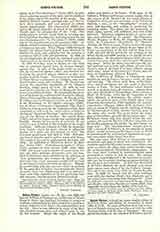

Saint-Victor, Abbey of.—In the year 1108, the famous William of Champeaux, archdeacon of Notre-Dame in Paris, who had been lecturing to crowds of students, relinquishng his chair, retired to a small hermitage dedicated to St. Victor, the martyr soldier, near the city. Here he was followed by many of his disciples, Abelard among them, and induced again to take up his lectures. Hence the origin of the Royal Abbey and School of St-Victor. With some of his followers, William had become a canon regular, but, at the request of St. Bernard he was made Bishop of Châlons in 1113, and was succeeded at St-Victor‘s by Gildwin, a man, as the “Necrologium” records, of piety and learning, and zealous in promoting the canonical order. The abbey, by the generosity of popes, kings, queens, and noblemen, was soon richly endowed. Numerous religious houses of canons regular were reformed by its canons. Ste-Genevieve (Paris), Wigmore in Wales, St. Augustine’s (Bristol, 1148), St. Catherine’s (Waterford), St. Thomas’s (Dublin), St. Peter’s (Aram, Naples) were of the number. No less than forty abbeys of the Order of St. Victor are mentioned in his last will by King Louis VIII, who left all his jewels for the erection of the abbey church and 4000 pounds to be equally divided among them. At the general chapter which was convened every year, there were present some 100 abbots and priors. Before the abbey was 160 years old, several cardinals and at least eight abbots, all sons of St-Victor‘s, were at the head of as many abbeys, among them John, Abbot of, Ste-Genevieve (Paris), and Andrew, an Englishman, Abbot of Wigmore.
The traditions of William of Champeaux were handed on, and St-Victor‘s became a center of piety and learning. The school, with those of Ste-Genevieve and Notre-Dame, was the cradle of the University of Paris. To that celebrated school flocked crowds of students from all countries. Among them were men like Hugh of Blankenburg, better known as Hugh of St-Victor, called the St. Augustine of his time; Richard, a Scotchman, the mystic doctor; Adam, the greatest poet of the Middle Ages; Peter Comestor, the historian; Peter Lombard, the magister sententiarum; Thomas, Abbot of St. Andrew’s (Verceil), to whom St. Francis sent St. Anthony of Padua for his theological studies; another Thomas, prior at the abbey who, nearly fifty years before his namesake of Canterbury, gave his life for justice sake. To St-Victor‘s came, only four months before his martyrdom, the same St. Thomas à Becket and addressed his brother canons on the words: “In pace factus est locus ejus”. The “Scotichronicon” records that in 1221 a canon of St-Victor‘s, in his capacity of papal legate, visited Ireland and Scotland, where at Perth he convoked all the ecclesiastical dignitaries to a general convention which lasted four days.
The time came when abbots in commendam were introduced and signs of decay were manifested. Towards the end of the fifteenth century some efforts were made to reform the abbey with canons brought from the newly-established Windesheim congregation. A few years later Cardinal de Larochefoucauld again attempted to reform it, but in vain. The canons, moreover, were implicated in the Jansenist movement, only one, the Venerable Jourdan, remaining faithful to the old spirit and traditions. At that time there lived at St-Victor Santeul, the great classical poet, whose Latin proses were adopted by the Gallican Liturgy. The end of the abbey came with the French Revolution. In 1800 the church and the other buildings were sold, the famous library was dispersed, and a few years later everything had disappeared. There are still a few convents of canonesses, at Bruges, Ypres, and Neuilly, who keep the rule and spirit which they originally received from the Abbey of St-Victor‘s.
A. ALLARIA

